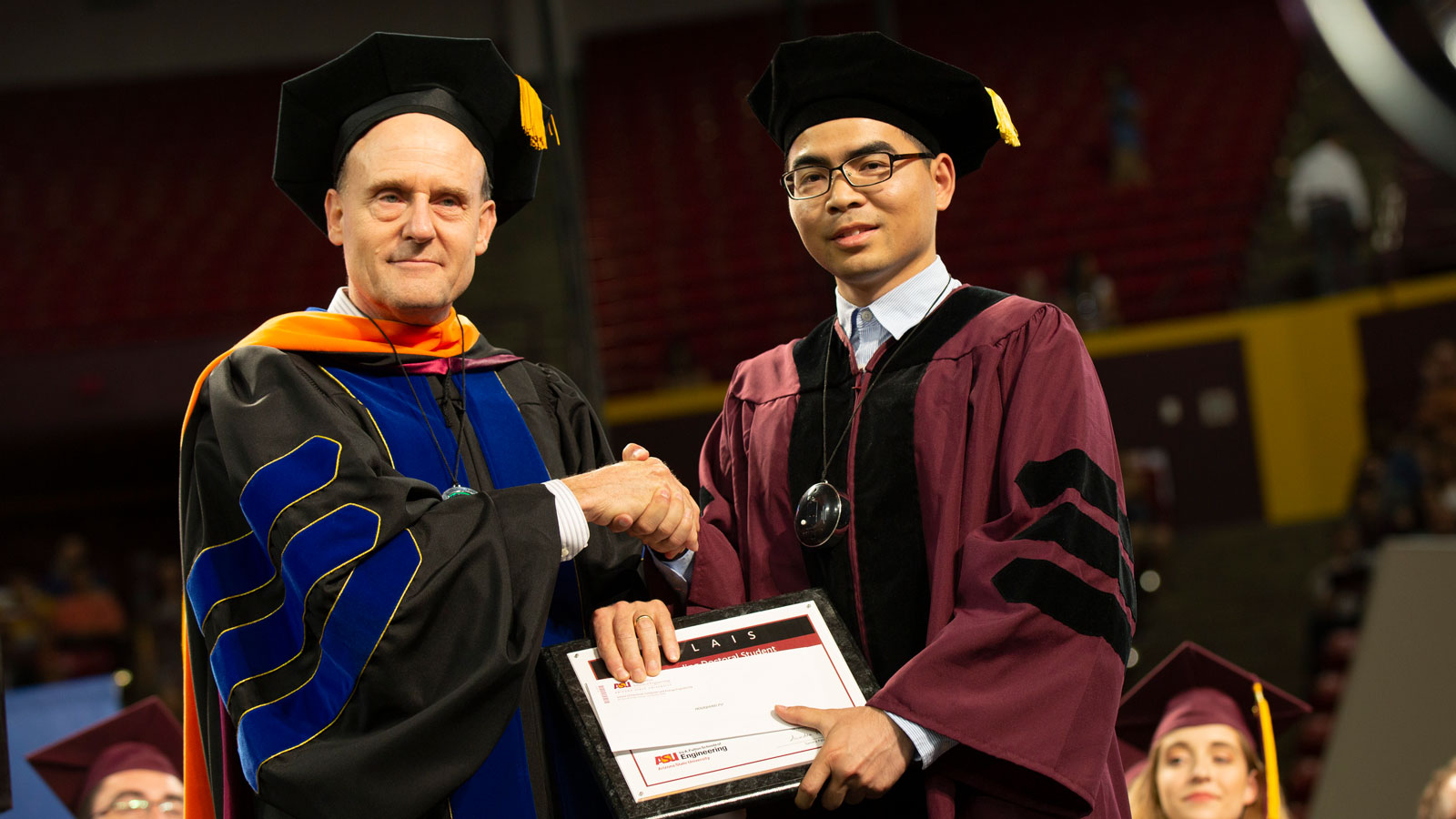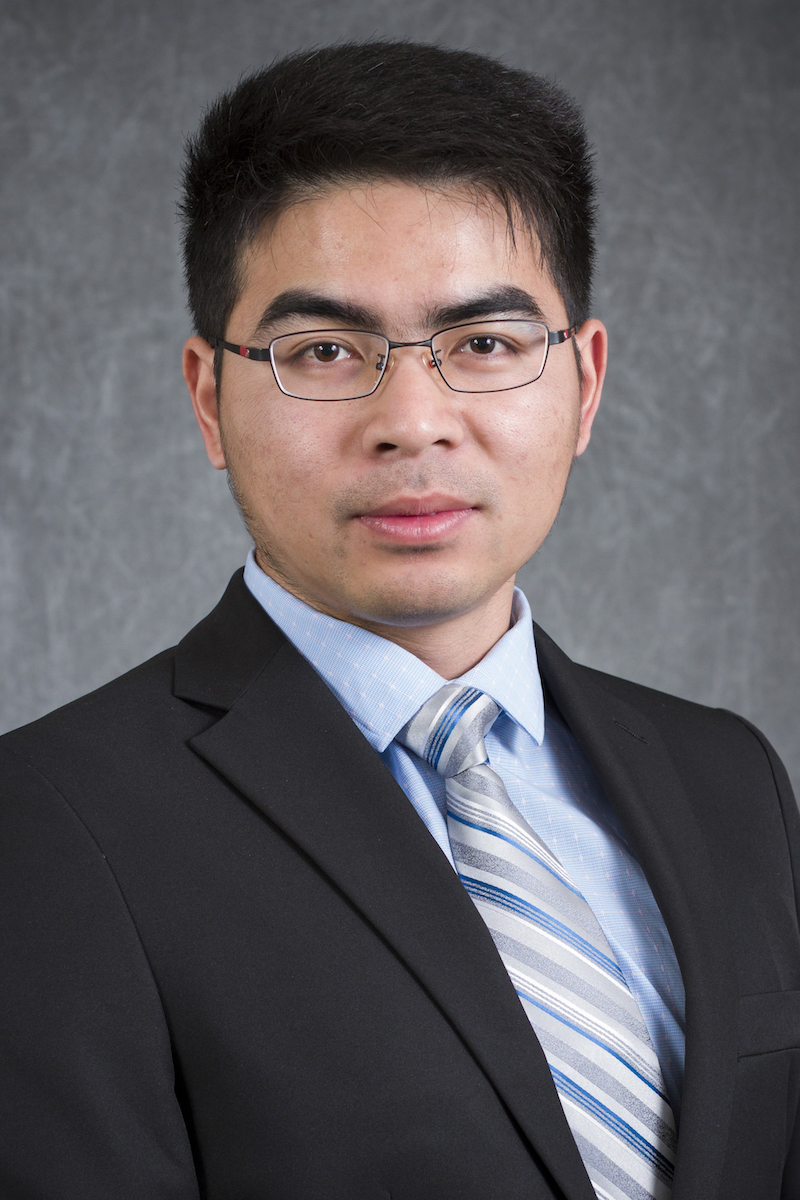
Influential research into power electronics earns high recognition

Above: Stephen Phillips (left), professor and director of the School of Electrical, Computer and Energy Engineering, presents doctoral graduate Houqiang Fu with the 2019 Palais Outstanding Doctoral Student Award at the spring 2019 Fulton Schools Convocation ceremony. Fu's academic excellence and important research on gallium nitride power electronics that operate more quickly and efficiently to save energy earned him this prestigious award. Photographer: Jessica Hochreiter/ASU
Power electronics are the middle step between the electrical grid and your electronic devices. They switch on and off to convert the electricity from your outlets to suitable currents and voltages used by computers, smartphones, appliances, data center servers and more.

Houqiang Fu
With the rise of smartphones, wearable technology, cloud computing, artificial intelligence and electric vehicles — and the increase in data centers needed for the vast amount of data generated by the internet of things — more efficient power electronics are needed to keep energy usage from skyrocketing.
Houqiang Fu recently successfully defended his dissertation and received his doctoral degree from the Ira A. Fulton Schools of Engineering at Arizona State University, where he researched gallium nitride power electronics that operate more quickly and efficiently to save energy.
His work in this area earned him the 2019 Palais Outstanding Doctoral Student Award for research and academic excellence. At the spring 2019 Fulton Schools convocation, Fu received a commemorative plaque and a $1,000 check.Emeritus Professor Joseph Palais and his wife, Sandra Palais, established the Palais Outstanding Doctoral Student Award in 2003 to honor exceptional electrical engineering doctoral students in the School of Electrical, Computer and Energy Engineering, one of the six Fulton Schools.
“I am deeply honored to receive this prestigious award,” Fu says. “I am also very excited that my work in power electronics is well appreciated by the community. This award will be an important driving force for me to further pursue my career in this field.”
Gallium nitride is what is known as a wide-bandgap semiconductor material. Its material properties allow for semiconductor devices to be smaller and operate more efficiently at higher voltages, frequencies and temperatures than silicon-based semiconductor materials.
Gallium nitride gained widespread attention in 2014 when research into gallium nitride light emitting diodes, or LEDs, earned the Nobel Prize in Physics. Fu took notice of the material’s potential and dove work on its other applications.
“The recent advent of gallium nitride has completely transformed the technological landscape of power electronics because they can drastically reduce power conversion losses compared to traditional semiconductors such as silicon,” Fu says. “It’s estimated gallium nitride can help reduce up to 70% to 90% of power conversion losses.”
Currently, about 10% of the total electricity generated in the United States is lost through power conversion using silicon-based devices. With silicon power electronics having reached their performance limit, Fu’s research demonstrated gallium nitride power electronics can be smaller, faster and more efficient.
Fu took advantage of the diverse research backgrounds of faculty in the School of Electrical, Computer and Energy Engineering by collaborating with Stephen Goodnick, a professor of electrical engineering who is an expert on various aspects of semiconductors.
Fu often took an interdisciplinary approach to his research and kept an open mind about how other scientific and engineering fields could help him. Fu reached out beyond electrical engineering faculty to Fernando Ponce, a professor of physics, who helped him understand the underlying physics and materials science involved in his research.
“Ideas from other areas may be able to be applied to your research and give you new perspectives,” Fu says. “To widen my horizons, I often read broadly, attended seminars focused on different disciplines, and talked to researchers with different expertise.”
However, Fu’s mentor and advisor, Professor Yuji Zhao, was most instrumental to his success.
“He gave me a lot of freedom to explore during research,” Fu says. “He is also very patient, encouraging and optimistic when experiments don’t go well. And Dr. Zhao has created a very collaborative and dynamic group culture. It feels very comfortable and motivating to be in such a group.”
Zhao is a prominent gallium nitride researcher, and has earned funding from the U.S. Department of Energy Advanced Research Projects Agency-Energy, NASA and more.
Fu’s research “comprises a combination of efforts from theoretical modeling, materials engineering and device characterization,” Zhao says, “It is a powerful example of interdisciplinary research, which not only exemplifies a very high level of intellectual merit, but also has a broad scientific impact.”
Zhao says Fu “has substantially advanced the state-of-the-art power electronics technology, and has a profound impact on large-scale societal problems in energy efficiency, renewable energy and power infrastructure.”
Zhao is also impressed by the amount of technically significant results Fu achieved over the past five years, which Fu has shared in more than 30 peer-reviewed journal and conference publications, one book chapter, three patents pending and more than 30 conference presentations.
“His record of accomplishment is among the best that I have seen for a PhD student,” Zhao says. “I have no doubt that he will have a very bright future in research. His success story has shown to us that at ASU we can produce great PhD students on par with MIT, Stanford and Berkeley.”
In 2014, Fu chose to attend ASU because of the institution’s strong materials science, solid-state device and physics research. After graduating with a bachelor’s degree in material physics, Fu wanted to get hands-on with those materials for his graduate studies.
“After graduation, I was eager to apply my knowledge in material physics to real devices and products that can really be used to benefit society,” Fu says. “Electrical engineering is a perfect major that mixes materials, devices and applications.”
He has been pleased with the facilities, research and collaboration opportunities he has had access to at ASU.
Now that he has completed his doctoral degree, he encourages other students to never give up during their graduate journeys.
“Stay optimistic and keep trying because there inevitably are many trials and errors awaiting you in research,” he says.
After graduation, Fu will continue working in Zhao’s lab as a postdoctoral researcher.



































